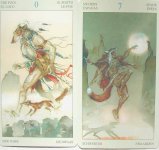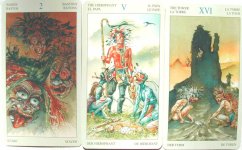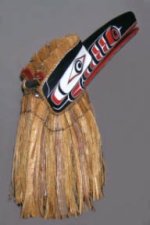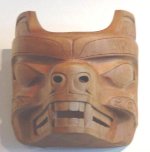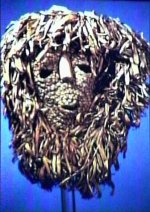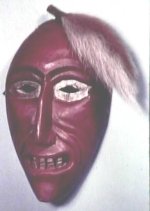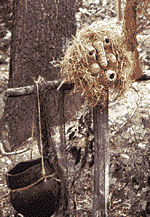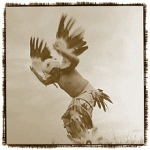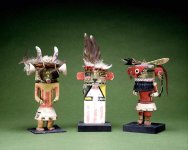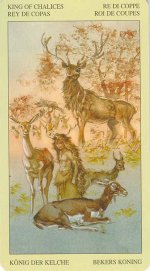Mi-Shell
Fox Medicine part 1
There are 2 foxes on these cards: one runs with our Fool, Older Brother Coyote and the dancing Fox on the 7 of Swords.
While everyone knows everything about Coyote the trickster and "anti-hero" of Native America here is some info about Wa guish the Fox:
LEGENDS AND TRADITI0NS ABOUT THE FOX:
The Persistence and Gentleness of the Fox
Just as the badger was seen to represent what could be called a diminutive expression of the bear principle, the fox resembled the larger wolf. The fox was considered to be persistent, yet was gentler and less aggressive than the wolf. This is undoubtedly the reason the Wolf Society was predominantly a War Society, while the Kit Fox Society (Takala) was one of the Akicita or policing societies whose duties centered less on warfare and more on camp life and hunting activities.
According to Standing Bear:
The fox had knowledge of underground things hidden from human eyes, and this he shared with the dreamer, telling him of roots and herbs that were healing and curing; then he shared his powers of swiftness and cleverness as well as gentleness.
In this gentleness, there was strength and courage, as indicated by one of the songs of the Fox Society: "1 am a Fox. I am supposed to die. If there is anything difficult, if there is anything dangerous, that is mine to do.
A Miwok tale credits the silver fox and coyote with the creation of the universe. In the time of mists, in the time before time began, there was nothing but water and a single fox. Feeling lonely, the fox began to sing:
'I want to meet someone.' Coyote appeared. The two walked together, and fox suggested that they create the world. Coyote asked, 'How?'
'We shall sing it into being,' fox said, and she thought of a lump of clay. It materialized in her hands. She threw it to the ground, and coyote and fox sang the mountains, the valleys, rivers and lakes. They danced until the earth grew around them, and that is how the world began.
Further east, fox was linked with warriors. Typical policing societies of the Plains included the Kit Fox Society of the Lakota, the Dog soldiers of the Cheyenne, and the Fox Society of the Crow. The members of the latter group strove amongst themselves to strike the first blow against the enemy. The leaders carried a staff which, when they dismounted, they planted and refused to move from that spot, even when other members of the tribe retreated.
Fox shares many characteristics with ferret, in its ability to move unseen and its cunning. Other common attributes include: camouflage, swiftness, shapeshifting, invisibility - all important abilities for the warrior.
The Inuit recognized the 'magic' of foxes and feared them. After a kill, the fox was hamstrung so that the spirit could not re-animate the body, for if it were to walk again it might take revenge on the hunter.
The kit fox was revered all across the Plains. It remains an important animal to this day. In 1800, the Kit Fox Society was one of the great warrior societies of Oglala Sioux. They were also used as internal 'police' or marshals of the camp. Therefore, they were guardians of the tribe.
The members of the Kit Fox Society painted their bodies, faces and arms yellow. If the leader was to be handling sacred things, such as during the Sun Dance, his hands would be painted red. A yellow fox skin suspended from the right hand was a badge of membership. An eagle feather attached to the fur was the mark of a leader. Red bird plumes and a war club indicated readiness for battle.
The warriors, or foxes, were stake-holders whose duty it was to defend the helpless unto death in case the village was attacked. It was after the death of four of these warrior-foxes, all stake-holders and sons of the chief, that their grieving father sought a vision. He was told of two children who needed him. He sought and found these two abandoned children, a boy and a girl, and raised them as his own. Before his death, he held a feast and told his people that if one's heart was good towards another, they should become as one family. Thus, one of the seven important rites, the Hunka (adoption) ceremony of the Lakota, was born from the sacrifice made by Kit Fox warriors.
A person did not ask to join the Kit Fox Society, but was nominated and then invited to join. The ceremony was complex. Once a member, it was believed that the man could not lie. If later the warrior was wounded, it was thought that he must have done something wrong or broken his vows. Otherwise, he would have remained invincible. .
And the women of the Oglala also have a Kit Fox Society. For man or woman, kit fox imparts the laudable qualities of constancy, courage and integrity. These women are stern defenders of their families. As an animal, kit fox is a good parent; therefore, women who are endowed with kit fox medicine are conscientious mothers.
Medicine and Powers:
Cunning, dexterity, speed, agility, invisibility subtlety, wisdom, trickery and guile; (depending on tribe and species): protection, family, maternal instinct, camouflage, healing, invisible presence.
The Hopi used fox furs for healing and in shamans' robes. The healing action took place by the holy man placing the fur on the affected part and drawing the sickness away.
Many Native American tribes wore a fox skin or held ceremonies to invoke its power. It was believed that, worn on the head, the skin imparted fox's inteIligence to the individual. Meanwhile the tail of the fox often graced the medicine man's spirit poles (the Plains' equivalent to northwestern totem poles, or the Celtic wand or wizard's staff).
Fox teaches subtlety and imparts the ability to run like the wind.
These are warrior traits. Fox is decisive and sure-footed in the physical world. It is swiftness of thought in the intellectual.
There are 2 foxes on these cards: one runs with our Fool, Older Brother Coyote and the dancing Fox on the 7 of Swords.
While everyone knows everything about Coyote the trickster and "anti-hero" of Native America here is some info about Wa guish the Fox:
LEGENDS AND TRADITI0NS ABOUT THE FOX:
The Persistence and Gentleness of the Fox
Just as the badger was seen to represent what could be called a diminutive expression of the bear principle, the fox resembled the larger wolf. The fox was considered to be persistent, yet was gentler and less aggressive than the wolf. This is undoubtedly the reason the Wolf Society was predominantly a War Society, while the Kit Fox Society (Takala) was one of the Akicita or policing societies whose duties centered less on warfare and more on camp life and hunting activities.
According to Standing Bear:
The fox had knowledge of underground things hidden from human eyes, and this he shared with the dreamer, telling him of roots and herbs that were healing and curing; then he shared his powers of swiftness and cleverness as well as gentleness.
In this gentleness, there was strength and courage, as indicated by one of the songs of the Fox Society: "1 am a Fox. I am supposed to die. If there is anything difficult, if there is anything dangerous, that is mine to do.
A Miwok tale credits the silver fox and coyote with the creation of the universe. In the time of mists, in the time before time began, there was nothing but water and a single fox. Feeling lonely, the fox began to sing:
'I want to meet someone.' Coyote appeared. The two walked together, and fox suggested that they create the world. Coyote asked, 'How?'
'We shall sing it into being,' fox said, and she thought of a lump of clay. It materialized in her hands. She threw it to the ground, and coyote and fox sang the mountains, the valleys, rivers and lakes. They danced until the earth grew around them, and that is how the world began.
Further east, fox was linked with warriors. Typical policing societies of the Plains included the Kit Fox Society of the Lakota, the Dog soldiers of the Cheyenne, and the Fox Society of the Crow. The members of the latter group strove amongst themselves to strike the first blow against the enemy. The leaders carried a staff which, when they dismounted, they planted and refused to move from that spot, even when other members of the tribe retreated.
Fox shares many characteristics with ferret, in its ability to move unseen and its cunning. Other common attributes include: camouflage, swiftness, shapeshifting, invisibility - all important abilities for the warrior.
The Inuit recognized the 'magic' of foxes and feared them. After a kill, the fox was hamstrung so that the spirit could not re-animate the body, for if it were to walk again it might take revenge on the hunter.
The kit fox was revered all across the Plains. It remains an important animal to this day. In 1800, the Kit Fox Society was one of the great warrior societies of Oglala Sioux. They were also used as internal 'police' or marshals of the camp. Therefore, they were guardians of the tribe.
The members of the Kit Fox Society painted their bodies, faces and arms yellow. If the leader was to be handling sacred things, such as during the Sun Dance, his hands would be painted red. A yellow fox skin suspended from the right hand was a badge of membership. An eagle feather attached to the fur was the mark of a leader. Red bird plumes and a war club indicated readiness for battle.
The warriors, or foxes, were stake-holders whose duty it was to defend the helpless unto death in case the village was attacked. It was after the death of four of these warrior-foxes, all stake-holders and sons of the chief, that their grieving father sought a vision. He was told of two children who needed him. He sought and found these two abandoned children, a boy and a girl, and raised them as his own. Before his death, he held a feast and told his people that if one's heart was good towards another, they should become as one family. Thus, one of the seven important rites, the Hunka (adoption) ceremony of the Lakota, was born from the sacrifice made by Kit Fox warriors.
A person did not ask to join the Kit Fox Society, but was nominated and then invited to join. The ceremony was complex. Once a member, it was believed that the man could not lie. If later the warrior was wounded, it was thought that he must have done something wrong or broken his vows. Otherwise, he would have remained invincible. .
And the women of the Oglala also have a Kit Fox Society. For man or woman, kit fox imparts the laudable qualities of constancy, courage and integrity. These women are stern defenders of their families. As an animal, kit fox is a good parent; therefore, women who are endowed with kit fox medicine are conscientious mothers.
Medicine and Powers:
Cunning, dexterity, speed, agility, invisibility subtlety, wisdom, trickery and guile; (depending on tribe and species): protection, family, maternal instinct, camouflage, healing, invisible presence.
The Hopi used fox furs for healing and in shamans' robes. The healing action took place by the holy man placing the fur on the affected part and drawing the sickness away.
Many Native American tribes wore a fox skin or held ceremonies to invoke its power. It was believed that, worn on the head, the skin imparted fox's inteIligence to the individual. Meanwhile the tail of the fox often graced the medicine man's spirit poles (the Plains' equivalent to northwestern totem poles, or the Celtic wand or wizard's staff).
Fox teaches subtlety and imparts the ability to run like the wind.
These are warrior traits. Fox is decisive and sure-footed in the physical world. It is swiftness of thought in the intellectual.

